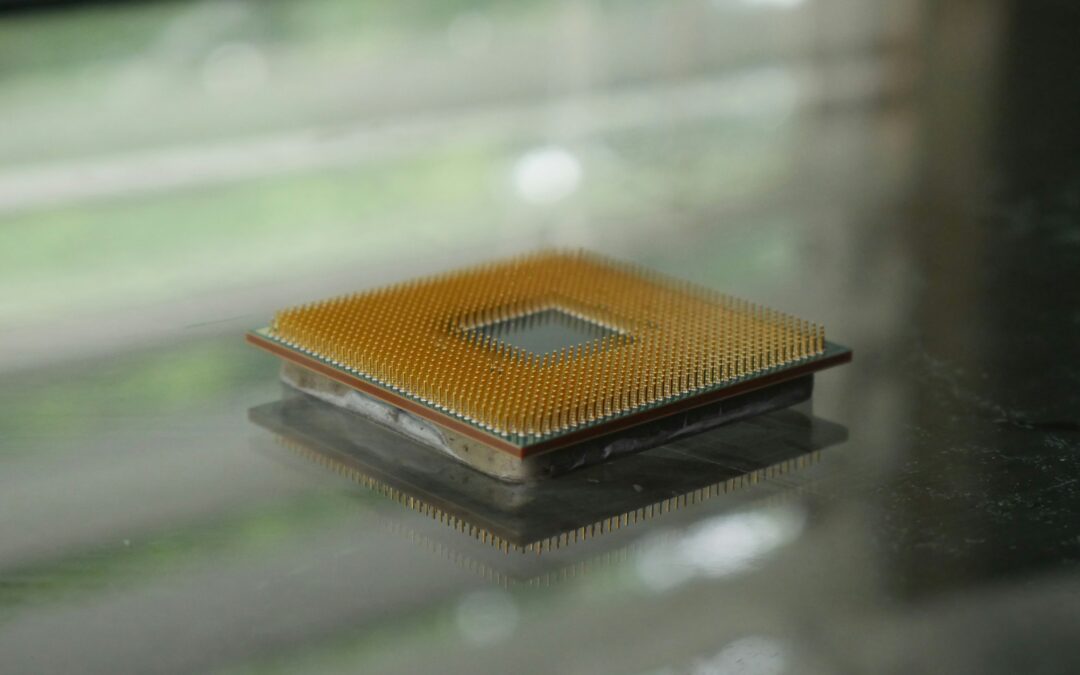The digital world is on the brink of change. Edge computing is moving data processing closer to the source. This Decentralized data processing promises a future with faster response times and more efficient use of the Internet of Things. 2024 will be a key year for edge computing benefits.
Edge computing makes it possible to process data directly at the point of origin. This reduces delays and improves reliability. The potential of this technology is particularly evident in areas such as healthcare and manufacturing. It drives the digital transformation and shapes the way we handle data.
Important findings
- Edge computing optimizes data processing in the Internet of Things
- Reduced latency times through Decentralized data processing
- Applications in healthcare and Industry 4.0
- Improved efficiency and reliability in IoT networks
- Edge computing as a key technology for the digital transformation
Introduction to Edge Computing
Edge computing is revolutionizing the way we process and use data. This innovative technology brings computing power closer to the data source, enabling more efficient use of IoT technologies.
Definition and basics
Edge computing is a form of decentralized data processing that takes place at the edge of the network. Instead of sending data to remote data centers for processing, it is analyzed directly at the point of origin. This leads to reduced latency times and faster data processing.
Development of edge computing
The emergence of edge computing is closely linked to the growth of the Internet of Things. With the increasing number networked devices the need for fast, local data processing has increased. Edge computing was created in response to this challenge and enables the efficient use of IoT technologies.
Significance for the Internet of Things
Edge computing is of crucial importance for IoT applications. It enables real-time analysis and fast reactions to local events. This is particularly important in areas such as autonomous driving or industrial automation, where every millisecond counts.
| Aspect | Traditional data processing | Edge Computing |
|---|---|---|
| Latency time | High | Low |
| Data transmission | High bandwidth required | Reduced bandwidth requirements |
| Real-time processing | Restricted | Possible |
| Energy efficiency | Lower | Higher |
Edge computing thus offers a solution to the challenges of modern data processing and lays the foundation for advanced IoT applications.
Edge computing advantages 2024
The Edge computing advantages 2024 offer companies numerous opportunities to optimize their processes. By processing data at the point of origin, edge computing enables faster response times and improved efficiency.
Local data analysis plays a central role in the benefits of edge computing. By processing information directly at the source, latency times are minimized and real-time capability is increased. This is particularly important for time-critical applications in areas such as autonomous driving or industrial control systems.
Another significant advantage is the increased Energy efficiency. As less data has to be transmitted over long distances, energy consumption for data transmission and storage is significantly reduced.
| Advantage | Description |
|---|---|
| Real-time processing | Minimized latency times through local data analysis |
| Energy efficiency | Reduced energy consumption due to less data transmission |
| Data security | Improved security through decentralized data processing |
| Cost savings | Lower costs for data transfer and cloud storage |
The advantages of Edge Computing 2024 also extend to the area of data security. The decentralized processing of sensitive information minimizes the risk of data breaches. Companies also benefit from cost savings, as less data needs to be transferred to and stored in the cloud.
Technological basics of edge computing
Edge computing is based on advanced technological components that enable efficient data processing at the edge of the network. These foundations include special hardware, innovative software and a powerful Network infrastructure.
Hardware requirements
Powerful devices are essential for edge computing. Multicore processors and ASICs (application-specific integrated circuits) are at the heart of edge systems. Effective cooling is crucial to ensure performance at high computing power.
Software solutions
Scalable edge solutions require specialized software. This includes customized operating systems and powerful analysis tools. This software enables the rapid processing and evaluation of data directly at the point of origin.
Network infrastructure
The Network infrastructure plays a key role in edge computing. 5G connectivity forms the backbone for fast data transmission between edge devices and central systems. This modern infrastructure enables real-time data processing and minimizes latency times.
| Component | Function | Example |
|---|---|---|
| Hardware | Data processing | Multicore processors, ASICs |
| Software | Data analysis | Specialized operating systems |
| Network | Data transmission | 5G technology |
The combination of these technological foundations makes it possible to use edge computing efficiently and reliably in various IoT applications. The continuous further development of these components is driving innovation in the field of edge computing.
Edge computing vs. cloud computing
The choice between Edge Computing and cloud Computing is a key issue for many companies. Edge computing, a form of decentralized data processing, offers unique advantages over traditional data processing. Cloud technologies.
Edge computing is characterized by faster data processing and lower latency times. This is particularly important for applications that require real-time responses. Cloud computing, on the other hand, excels at storing and processing large volumes of data.
Many companies rely on Hybrid solutionswhich combine the strengths of both approaches. This combination enables optimum performance and maximum flexibility.
| Criterion | Edge Computing | Cloud computing |
|---|---|---|
| Latency time | Very low | Higher |
| Data storage | Limited | Virtually unlimited |
| Real-time processing | Ideal | Restricted |
| Scalability | Locally limited | High |
The decision between edge and cloud depends on the company's specific requirements. Edge computing is often the better choice for IoT applications with real-time requirements, while data-intensive analyses are more effective in the cloud.
Edge computing enables rapid responses directly at the point of action, while cloud computing unleashes the power of data analysis on a grand scale.
By combining both technologies in hybrid solutions, companies can benefit from the advantages of both worlds and optimize their digital infrastructure.
Application areas of edge computing in the IoT
Edge computing is revolutionizing numerous areas of the Internet of Things. The technology enables fast data processing directly at the point of origin and opens up new possibilities for innovative applications.
Smart cities and infrastructure
In Smart Cities Edge computing plays a key role here. Traffic control systems use real-time data analysis to reduce congestion and optimize traffic flow. Environmental sensors monitor air quality and noise levels, making cities more liveable.
Industry 4.0 and manufacturing
The Industry 4.0 benefits enormously from edge computing. Production plants are controlled more efficiently by processing data directly on site. Predictive maintenance prevents breakdowns and saves costs. Robots in production lines react to changes in real time.
Healthcare and medical technology
In the healthcare sector, edge computing enables the continuous monitoring of patients. Wearables send vital data to edge devices, which can react immediately to critical values. Telemedicine is improved by fast data processing, which is particularly beneficial in rural areas.
| Area of application | Edge computing advantages | Examples |
|---|---|---|
| Smart Cities | Real-time control, local data processing | Intelligent traffic light systems, parking lot management |
| Industry 4.0 | Fast response times, process optimization | Autonomous robots, quality control in real time |
| Healthcare | Data protection, low latency | Remote monitoring of patients, AI-supported diagnosis |
The diverse Edge computing use cases show the enormous potential of this technology for the future of the IoT. From Smart Cities up to the Industry 4.0 - Edge Computing drives innovation and efficiency.
Security and data protection in edge computing

Edge computing has revolutionized the way we process data. It offers a Improved data security by processing sensitive information directly at the point of origin. This local data analysis minimizes the risk of data loss during transfer.
The advantages of edge computing for the Data protection are considerable:
- Reduced latency times
- Reduced network load
- Better control over sensitive data
Companies are increasingly relying on encryption technologies and strict access controls to protect the Data protection in edge environments. These measures are crucial for the security of the information processed.
| Aspect | Traditional cloud | Edge Computing |
|---|---|---|
| Data processing | Central | Local |
| Latency | Higher | Lower |
| Data protection | Dependent on cloud security | Improved control |
Local data analysis enables companies to react more quickly to potential security threats. By processing data at the edge of the network, the attack surface for cyber criminals is significantly reduced.
Edge computing is not just a technological innovation, but a paradigm shift in data security.
Despite the benefits, organizations face the challenge of developing robust security protocols for their edge infrastructure. The balance between Data protection and functionality remain a central topic in the further development of edge computing.
Challenges and solutions
Edge computing faces a number of hurdles that need to be overcome. We look at the most important challenges and highlight innovative solutions.
Scalability
The rapid increase in networked devices requires Scalable edge solutions. Companies rely on modular architectures and containerized applications. These enable flexible adaptation of computing power to changing requirements.
Energy efficiency
Edge systems often have to make do with a limited power supply. Advances in processor technology and intelligent energy management increase energy efficiency. Passive cooling concepts also reduce power consumption.
Standardization
A lack of uniform standards makes the interoperability of edge systems more difficult. Initiatives such as the Open Edge Computing Project are driving the Standardization ahead. The aim is to create open interfaces for the seamless integration of various edge solutions.
| The challenge | Solution approach |
|---|---|
| Scalability | Modular architectures, container technologies |
| Energy efficiency | Energy-saving processors, intelligent energy management |
| Standardization | Industry initiatives, open interfaces |
Overcoming these challenges paves the way for the widespread adoption of edge computing. Innovative solutions are driving the technology forward and opening up new fields of application in the Internet of Things.
Future prospects for edge computing
The future of edge computing promises exciting developments. Edge computing advantages 2024 are further strengthened by advanced technologies. The integration of artificial intelligence and machine learning into edge systems opens up new possibilities for real-time analysis and autonomous decision-making.

5G connectivity plays a key role in the further development of edge computing. The high bandwidth and low latency of 5G enable faster data transmission and processing at the edge of the network. This leads to improved applications in areas such as autonomous driving and industrial automation.
Experts are predicting a boom in the development of advanced edge analytics. These technologies enable companies to process data directly at the point of origin and gain valuable insights. The combination of Edge computing and artificial intelligence will increase efficiency and productivity in various industries.
"Edge computing will revolutionize the way we process and use data. It is the key to realizing the full potential of the Internet of Things."
The future of edge computing promises seamless integration into the IoT ecosystem. By processing data closer to the source, latency times are reduced and efficiency is increased. This leads to smarter and more responsive IoT applications in smart citiesIndustry 4.0 and in the healthcare sector.
| Technology | Impact on edge computing |
|---|---|
| Artificial intelligence | Improved data analysis and autonomous decision-making |
| 5G connectivity | Faster data transmission and lower latency |
| IoT integration | More efficient and responsive applications |
Implementation of edge computing in companies
The introduction of edge computing requires a well thought-out strategy and careful planning. Companies need to consider various Edge computing use cases to find the best solutions for their needs.
Strategy development
When developing an edge computing strategy, it is important to define clear goals. Companies should analyze their business processes and identify areas where edge computing can offer added value. Choosing the right Implementation strategies is crucial for success.
Best Practices
Successful edge computing projects follow best practices:
- Step-by-step introduction Scalable edge solutions
- Ensuring compatibility with existing systems
- Employee training in dealing with new technologies
- Regular review and optimization of the implementation
Case studies
Specific examples show the benefits of edge computing in practice. An automotive manufacturer was able to increase production efficiency by 15% through the use of edge technologies. An energy company optimized the maintenance of its systems with Edge Computing, reducing downtime by 30%. These case studies underline the potential of edge computing use cases in various industries.
Conclusion
Edge computing is paving the way for the The future of data processing. The Edge computing advantages 2024 are diverse and are transforming the way we handle data in the Internet of Things. Faster response times and improved security make this technology a game changer in many industries.
The Decentralized data processing solves many of the challenges posed by traditional cloud computing. In smart cities, Industry 4.0 and healthcare, we are already seeing how edge computing is driving innovation and optimizing processes.
With a view to the The future of data processing edge computing is at the forefront. It promises further technological advances and new application possibilities. Companies that embrace this technology at an early stage can secure a decisive competitive advantage and fully exploit the opportunities of the digitalized world.


Recent Comments